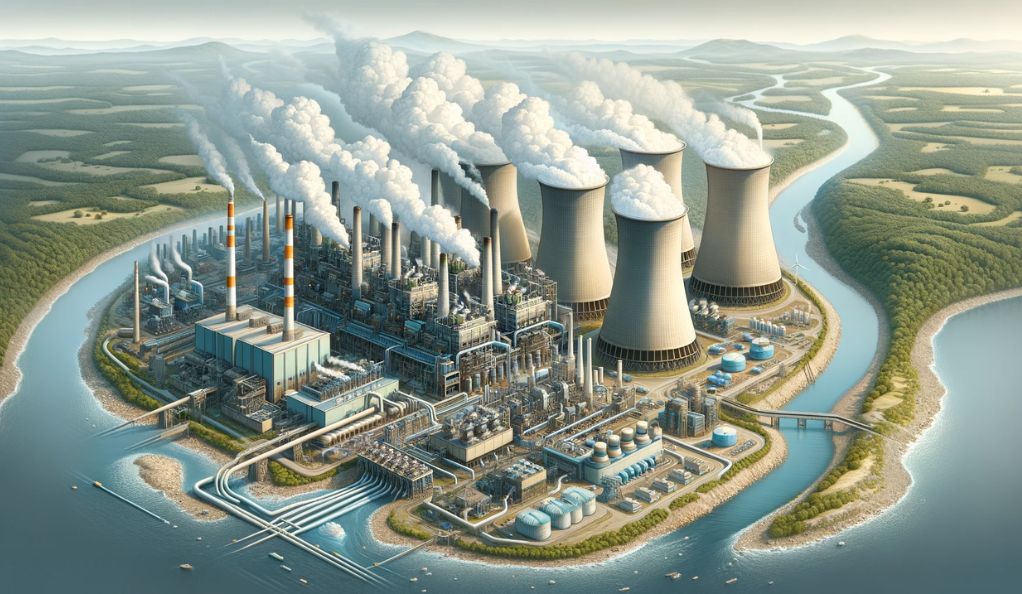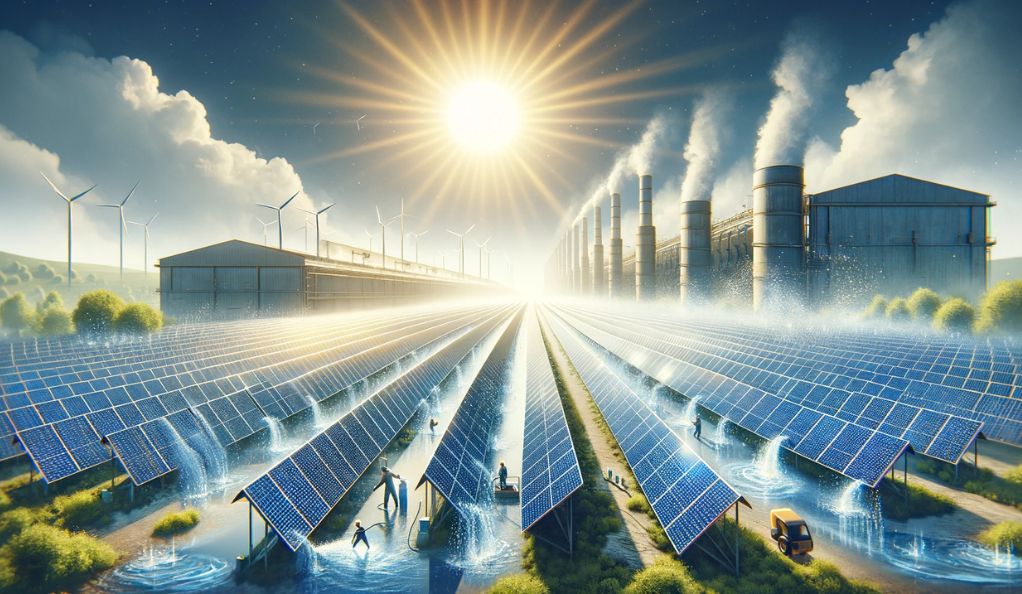In the quest for sustainable energy solutions, solar power has emerged as a beacon of hope. It promises a cleaner, greener future, contrasting sharply with the environmental baggage carried by traditional energy sources like coal, natural gas, and oil. However, when discussing environmental impacts, the conversation often orbits around carbon emissions and neglects another crucial factor: water usage. This article aims to shed light on this lesser-known yet vital aspect by comparing the water footprints of solar power and traditional energy sources.
The Essence of Water in Energy Production
Water plays a crucial but often underappreciated role in energy production. Traditional energy sources heavily rely on water for cooling power plants and refining fuels, resulting in substantial water footprints. For example, thermoelectric power plants in the United States use significant water volumes, mainly in once-through cooling systems, leading to substantial water withdrawals. In contrast, solar power emerges as a low-water-consuming alternative. Solar panels, the core of solar systems, operate without water, highlighting the efficiency and eco-friendliness of solar energy in comparison to water-hungry traditional methods.
Bridging the Data Divide: A Comparative Glance
To emphasize the impact, consider the numbers. The National Renewable Energy Laboratory (NREL) reports that solar photovoltaic (PV) systems use nearly 20 times less water per unit of electricity produced compared to coal-fired power plants, underlining solar power’s water conservation potential. In the United States, thermoelectric power once accounted for 41% of total water withdrawals, or 133 billion gallons daily. In contrast, California’s transition to solar energy has saved approximately 70 billion gallons of water annually, highlighting solar’s water-saving capabilities.
The Hidden Water Footprint of Solar Power
However, it’s essential to acknowledge that solar power isn’t entirely free of water usage. The manufacturing and maintenance of solar panels do involve water, albeit significantly less than traditional energy sources. From the production of silicon, a key component in solar panels, to the cleaning and maintenance of the panels, water is indeed a part of the solar energy lifecycle.
| Energy Source | Water Usage (gallons per MWh) |
|---|---|
| Coal-fired Power Plant | 500 – 600 |
| Natural Gas Power Plant | 100 – 300 |
| Nuclear Power Plant | 600 – 800 |
| Solar PV System | 20 – 50 |
Understanding the Water Footprint
The concept of a “water footprint” in energy production might be less familiar than carbon footprints, but it’s equally critical. This section delves into what a water footprint entails and why it’s a vital factor in assessing the environmental impacts of different energy sources.
What is a Water Footprint?
A water footprint measures the amount of water used to produce goods and services. In the context of energy production, it includes water used in the entire lifecycle of the energy source – from extraction or production of raw materials to the operational phase and even decommissioning or disposal.
Water Footprint of Solar Energy
Solar energy is often lauded for its minimal water usage during operation. Unlike fossil fuel-based power plants, solar panels do not require water for cooling. This dramatically reduces their operational water footprint. However, water is used in the manufacturing process of solar panels, particularly in the purification of silicon and washing and cooling during various manufacturing stages.
Water Footprint of Traditional Energy Sources
In contrast, traditional energy sources like coal, natural gas, and nuclear power have a more substantial water footprint. These sources primarily use water for cooling in power plants. The water is often drawn from nearby sources, used to absorb heat, and then returned at a higher temperature, impacting local ecosystems.
Solar Power’s Water Efficiency
Solar energy, renowned for its minimal environmental impact, stands out for its efficient water usage. This section explores how solar power conserves water, backed by relevant statistics and case studies, highlighting its superiority over traditional energy sources in terms of water footprint.
Conservation of Freshwater Resources
One of the most significant advantages of solar panels is their negligible operational water usage. Unlike fossil fuel-based power plants, solar panels do not require water for the generation of electricity. This characteristic is particularly beneficial in regions where water is scarce, ensuring that essential freshwater resources are conserved for other vital uses.
Solar Power’s Impact on Water Conservation
- California’s Solar Initiative: In California, a leader in solar energy adoption, the switch to solar power has significantly reduced water consumption in the energy sector. The California Energy Commission reported that solar energy has saved approximately 70 billion gallons of water annually, a stark contrast to the water-intensive cooling requirements of conventional power plants.
- National Scale: On a national level, the adoption of solar energy can lead to substantial water savings. A study by the National Renewable Energy Laboratory (NREL) found that solar photovoltaic (PV) systems consume about 20 times less water per unit of electricity generated than coal-fired power plants.
Environmental and Ecological Benefits
The reduction in water usage by solar power has broader environmental and ecological benefits. By minimizing water withdrawals from natural sources, solar energy helps reduce the stress on aquatic ecosystems often impacted by thermal pollution from power plants. This aspect is crucial in preserving biodiversity and maintaining the health of aquatic environments.
The Water Intensity of Traditional Energy Sources
In contrast to the water-efficient nature of solar energy, traditional energy sources such as coal, natural gas, and nuclear power are considerably more water-intensive. This section will examine the water footprint associated with these conventional energy sources, highlighting their environmental implications.
Water Use in Thermoelectric Power Plants

Thermoelectric power plants, which include coal, natural gas, and nuclear facilities, are among the largest users of water in the energy sector. These plants primarily use water for cooling purposes. There are two primary types of cooling systems: once-through and closed-cycle. Once-through systems withdraw large quantities of water, use it to absorb heat, and then discharge it back at a higher temperature, which can be harmful to aquatic life. Closed-cycle systems, on the other hand, reuse water, reducing total water withdrawals but still involving significant consumption.
Water Footprint of Coal, Natural Gas, and Nuclear Power
Each of these traditional energy sources has a distinct water footprint:
- Coal: The production of electricity from coal not only involves water for cooling but also for processes like ash handling and flue-gas desulfurization. The water footprint varies based on the technology and age of the plant.
- Natural Gas: Natural gas plants typically consume less water than coal or nuclear plants. However, the water footprint can be higher in certain extraction techniques like hydraulic fracturing (fracking), which uses large volumes of water.
- Nuclear: Nuclear power plants are among the most water-intensive, primarily due to their high heat outputs necessitating extensive cooling.
Environmental Impacts
The high water usage of traditional energy sources has several environmental consequences. It can lead to the depletion of local water resources, especially in water-scarce regions. The discharge of heated water into local water bodies can cause thermal pollution, which disrupts aquatic ecosystems. Additionally, water withdrawal can harm aquatic life, as organisms can be trapped or injured by intake screens.
Comparative Analysis of Water Footprints: Solar Power vs. Traditional Energy Sources
In this section, we’ll perform a comparative analysis of the water footprints associated with solar power and traditional energy sources like coal, natural gas, and nuclear power. This comparison is crucial in highlighting the environmental benefits of transitioning to renewable energy sources.
Comparative Framework
To understand the water footprint of each energy source, it’s important to consider the entire lifecycle of the energy production process, from the extraction or manufacturing of raw materials to the operational phase and eventual decommissioning.
Water Footprint Throughout the Energy Lifecycle
- Extraction and Manufacturing: The extraction of fossil fuels and the manufacturing of solar panels both involve water, but the scale is significantly different. While solar panel manufacturing has a moderate water footprint, primarily in the purification of silicon, fossil fuel extraction, especially in methods like fracking, can be highly water-intensive.
- Operational Phase: This is where solar power has a distinct advantage. Traditional energy sources require large amounts of water for cooling during power generation, whereas solar panels require no water to generate electricity.
- Decommissioning and Waste Management: In the decommissioning phase, solar panels, if not recycled, have a relatively low water footprint. In contrast, the decommissioning of nuclear plants and the management of coal ash ponds can be water-intensive.
The Case for Solar Power
Given its minimal operational water footprint, solar power emerges as an environmentally responsible choice, especially in the context of global water scarcity and the need for sustainable energy solutions. While the manufacturing and decommissioning phases do require water, the overall lifecycle water footprint of solar energy is considerably lower than that of traditional energy sources.
The Hidden Water Footprint of Solar Energy

While solar power is celebrated for its minimal water usage during operation, it’s important to shed light on its hidden water footprint, which encompasses the entire lifecycle of solar panels. This section will explore the water usage involved in the production, maintenance, and disposal stages of solar energy systems.
Sourcing of Raw Materials
The first stage in the lifecycle of a solar panel is the sourcing of raw materials. Key components like silicon, aluminum, glass, and polymers are essential for manufacturing solar panels. The extraction and processing of these materials can be water-intensive.
- Silicon Production: Producing crystalline silicon, a primary material in solar cells, involves processes like mining and refining, which require significant amounts of water for cooling and cleaning.
- Aluminum and Glass: Similarly, the production of aluminum and glass for frames and panels involves water-intensive processes.
Manufacturing and Production
After extracting raw materials, the manufacturing of solar panels involves multiple processes like shaping, doping, crystallizing, and encapsulating solar cells, which often require water usage. Water is primarily used for cooling and cleaning during these production stages, contributing to a significant water footprint. Therefore, adopting water-efficient production techniques is crucial in solar panel manufacturing.
Installation and Operation
- Maintenance: The operational phase of solar panels is virtually water-free in terms of electricity generation. However, maintenance, especially cleaning of the solar panels, does require water. In regions with high dust or pollen, regular cleaning is essential to maintain efficiency.
- Cooling in CSP Systems: Concentrated Solar Power (CSP) systems may use water for cooling, similar to traditional power plants, though this is a less common solar technology.
End of Life and Disposal
The final stage in the lifecycle of solar panels is their disposal or recycling, a critical step to prevent environmental damage. When solar panels end up in landfills, there is a risk of harmful substances leaching into the soil and water. In contrast, recycling solar panels not only prevents this pollution but also reduces the demand for new raw materials, helping to conserve resources and minimize water consumption during the manufacturing process.
Addressing the Water Footprint
While the hidden water footprint of solar energy is a concern, it’s crucial to compare it with the overall impact of traditional energy sources. Nevertheless, steps can be taken to minimize this footprint:
- Water-Efficient Technologies: Investing in research and development to create more water-efficient solar panel technologies.
- Responsible Sourcing: Implementing strategies that prioritize suppliers with low water intensity.
- Recycling and Reuse: Encouraging the recycling of solar panels and the use of recycled materials in production.
Conclusion
The comparison between the water footprints of solar power and traditional energy sources reveals a clear environmental advantage for solar energy. While solar power’s operational phase is remarkably water-efficient, its entire lifecycle, including manufacturing and disposal, still presents areas for improvement. As we confront global challenges like water scarcity and environmental sustainability, solar power emerges as a crucial player. By focusing on reducing the hidden water footprint and enhancing water conservation across all energy sources, we can make significant strides towards a more sustainable and water-responsible future.
